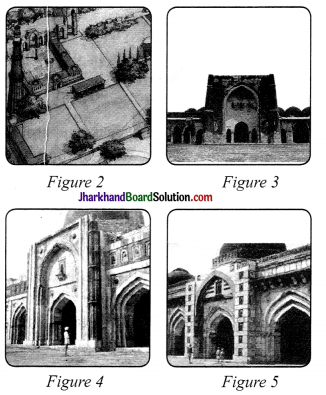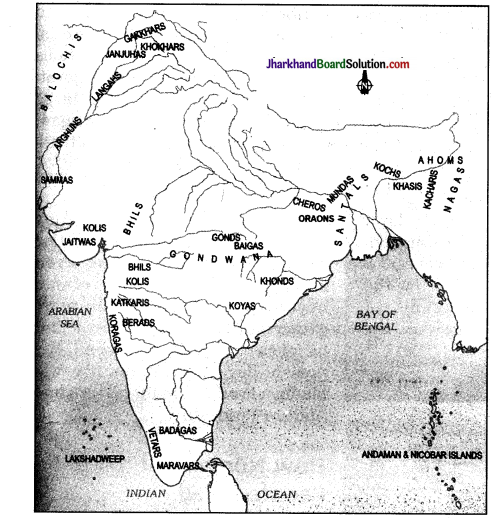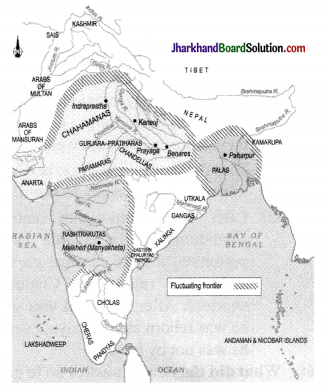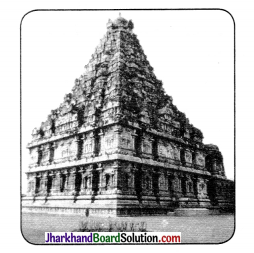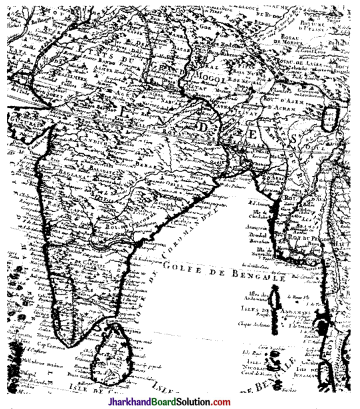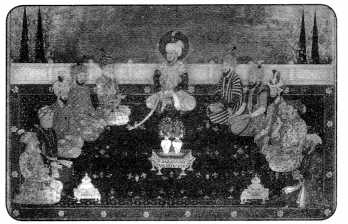JAC Board Class 7th Social Science Solutions History Chapter 8 Devotional Paths to the Divine
JAC Class 7th History Devotional Paths to the Divine InText Questions and Answers
Page 105
Question 1.
You can observe this process of local myths and legends receiving wider acceptance even today. Can you find some examples around you?
Answer:
Do it yourself. (Hint :Hinduism, the religion of the majority of the citizens of India, has varied faith whose local rituals and traditions are diverse.); Folk religion in Hinduism many explain the ’rationale behind local religious practices,and contain local myths that explain the existence of local religious customs or the location of temples.
Page 106
Question 2.
How does the poet describe his relationship with the deity?
Answer:
The poet feels his lord inside his body. Due to this reason, the poet is set free from sorrow, birth, death and illusion. He believes that nobody can separate him from God and salvaged with the light of the blessings of God.
![]()
Page 107
Question 3.
Try and find out more about the ideas of Shankara or Ramanuja.
Answer:
Shankara or Shankaracharya
- He was bom to a poor Brahmana couple in Kerala. He was one of the most authoritative and powerful philosophers of south India. He presented the idea of Advaita wich means idea of oneness of the individual soul and Supreme God. He believed, that a person could understand the ultimate reality and attain salvation only after following the path of renunciation and acquiring knowledge. Maya was neither an existence nor a non-existence and wasa therfore indescribable.
- Ramanuja
- Ramanuja was bom in Tamil Nadu. He was influenced by Alvars. He taught that an extreme devotion to God would help to attain salvation. He also gave the idea of Vishishtadvaita which means the soul remains distinct even after union with God.
Question 4.
What is the temple that Basavanna is offering to God?
Answer:
Basavanna is offering the temple of his body to his God. According to him, his legs are pillars, his body the shrine, and head a Cupola of gold.
Page 109
Question 5. Discuss the ideas about the social order expressed in these compositions.
Answer:
The ideas expressed by these composition are that God lives in the heart of all people irrespective of their caste, creed or gender. He treats the weak as his children which are in fact God themselves. If someone discriminates with these people then he should be ashamed of his own deed.
Page 115
Question 6.
Why do you think Mirabai left the Rana’s palace?
Answer:
Mirabai was a Rajput princess married into the royal family of Mewar. But she never liked the life of a palace. Hence, she left it and became a disciple of Ravidas, a saint from a caste considered “untouchable”. She, devoted her life to Lord Krishna and composed innumerable bhajans expressing her intense devotion. Her songs also openly challenged the norms of the ‘upper’ castes and became popular with the ordinary people. Once Mirabai drunk the poison sent by her husband. Still she did not die. The incident became very popular. People thought that she was saved by Lord Krishna. Thus she was proved to a true devotee.
Question 7.
In what ways are the ideas in this poem similar to or different from those of Basavanna and Jalaluddin Rumi?
Answer:
Similarity
- The idea of this poem stress on equality and against Brahmanas dominance and caste system. The central ideas of Kabir, Basavanna and Jalauddin Rumi emphases that the God resides within one’s heart. It cannot be found anywhere else on this earth.
Difference - No need to keep fast on Ramzan as Allah lives in the heart and not outside.
Page 120
Question 8.
Imagine, you are attending a meeting where a saint is discussing the caste system. Relate the conversation.
Answer:
The main points of the conversation are:
- Origin of the Caste system started from vama system.
- Division in the society.
- Caste conflicts’.
- Major ill effects of the caste system.
- How to remove the caste evils.
JAC Class 7th History Devotional Paths to the DivineTextbook Questions and Answers
( Let’s Recall)
Question 1.
Match the following:
| The Buddha | namghar |
| Shankaradeva | worship of Vishnu |
| Nizamuddin Auliya | questioned social differences |
| Nayanars | Sufi saint |
| Alvars | worship of shiva |
Answer:
| The Buddha | questioned social differences |
| Shankaradeva | namghar |
| Nizamuddin Auliya | Sufi saint |
| Nayanars | worship of Shiva |
| Alvars | worship of Vishnu |
Question 2.
Fill in the blanks:
(a) Shankara was an advocate of…..
(b) Ramanuja was influenced by the……
(c)…….. and …… were advocates of Virashaivism.
(d)…….. was an important centre of the Bhakti tradition in Maharashtra.
Answer:
(a) Advaita
(b) Alvars
(c) Basavanna, Allama Prabhu, Akkamahadevi
(d) Vitthala temple in Pandharpur.
Question 3.
Describe the beliefs and practices of the Nathpanthis, Siddhas and Yogis.
Answer:
The beliefs and practices of the Nathpanthis, Siddhas and Yogis were:
- They recommended the renunciation of the world.
- They fully believed that the path of salvation lay on meditation ‘ on the formless reality and the accomplishment of oneness with it.
- They recommended intense training of the mind and body through Yogasanas, meditation and breathing exercises to achieve salvation.
- They did not believe in conventional religion and rituals.
Question 4.
What-were the major ideas expressed by Kabir? How did he express these?
Answer:
Kabir’s teachings were based on a complete, indeed intense, rejection of the major religious traditions. His teachings openly questioned all forms of external worship of both Brahmanical Hinduism and Islam, the pre-eminence of the priestly classes and the caste system. Kabir believed in a formless Supreme God and preached that the only path to salvation was through bhakti or devotion.
![]()
He expressed these ideas through poetry and bhajans. The language of his poetry was in the form of hindi widely understood by ordinary people. Sometimes he used cryptic language which was difficult to understand. We get the information about his ideas from a huge collection of verses called sakhis and pads. It is said that it has been composed by Kabir itself and sung by wandering bhajan singers. Some of them were collected and preserved in the Guru Granth Sahib, bijak and Panch Vani.
(Let’s Understand)
Question 5.
What were the’ major beliefs and practices of the Sufis?
Answer:
The major beliefs and practices of the Sufis were:
- Sufis sought union with God.
- They also composed poems like the saint did, expressing their feelings and a rich literature in prose including anecdotes and fables developed around them.
- They often rejected the detailed rituals and codes of behaviour demanded by the Muslim religion scholar.
- They developed detailed methods of training using Zikr means chanting of a name or sacred formula, contemplation, sama means singing, raqs means dancing, discussion of parables, breath control, etc. under the guidance of a pir or master.
- Hence, emerged the silsilas, a genealogy of Sufi teachers each following a little different method or tariqa of ritual practice.
Question 6.
Why do you think many teachers rejected prevalent religious beliefs and practices?
Answer:
Many teachers rejected prevalent religious beliefs and practices because such beliefs advocated social differences, where the lower castes were oppressed by the upper castes. They believed in the power of personal devotion and felt attracted by the idea of a Supreme God, which believed that the only path to salvation was through bhakti or devotion.
Question 7.
What were the major teachings of Baba Guru Nanak?
Answer:
The major teachings of Baba Guru Nanak were:
- Baba gave special attention to the importance of the worship of one God.
- He insisted that caste, creed or gender was immaterial for attaining salvation. It was based on the persuit ‘ of active life with a strong sense of social commitment.
- He gave more importance to right belief, worship, honest living and helping others.
- Baba Guru Nanak also promoted the idea of equality.
- Nam, dan and isnan were the essence of his teaching which means right worship, welfare of others and purity of conduct.
- His teachings are now remembered as nam-japna, kirt-kama and vandchhakna, which also underline the importance of right belief and worship, honest living, and helping others. Thus, Baba GuruNanak’s idea of equality had social and political implications.
(Let’s Discuss)
Question 8.
For either the Virashaivas or the sants of Maharashtra, discuss their attitude towards caste.
Answer:
The Virashaivas or the sants of Maharashtra, their attitude towards caste were as follows:
- They believed in the equality for all people.
- Humanistic attitude was present in both of them.
- They were against the Brahmanical ideas about the conduct and behaviour of women and castes.
- Their belief was that Bhakti means sharing others’ pain.
- During the thirteenth to the seventeenth ‘centuries, Maharashtra saw a great number of saint-poets who rejected all forms of ritualism, outward display of piety and social differences based on birth.
- They always wished for society where people whether they are rich or poor, high or low could live in harmony and peace.
Question 9.
Why do you think ordinary people preserved the memory of Mirabai?
Answer:
Ordinary people preserved the memory of Mirabai because:
- She was married into a royal family as she was a Rajput princess. But, she had no interest in the worldly affairs.
- She was devoted to Krishna and composed many bhajans expressing her ardent devotion.
- Her devotion to her god was supreme. She lived a very simple life with the ordinary people.
- Her songs had challenged the upper caste and became very popular with the common people in Rajasthan and Gujarat.
(Let’s Do)
Question 10.
Find out whether in your neighbourhood there are any dargahs, gurudwaras or temples associated with saints of the bhakti tradition in your neighbourhood. Visit any one of these and describe what you see and hear.
Answer:
Need to do it yourself. (Hint : seen many people going their with devotion and do prayer and hear preaching of religious people with great devotion).
Question 11.
For any of the saint-poets whose compositions have been included in this chapter, find out more about their works, noting down other poems. Find out whether these are sung, how they are sung, and what the poets wrote about.
Answer:
We have read about many saint-poets who were bhakti saint or sufi saint. We learnt about Kabir, Tulsidas, Baba Guru Nanak, Mirabai and Surdas. Their religious works such as poems, bhajans are read out and sung at religious places by bhakti singers and poets. We hear these songs in television and radio.
Also, read many books about them. Kabrr’s dohas are very famous. Most of his work were concerned with devotion, mysticism and discipline. One of his famous doha has been translated: ‘Worry is such a thief that it eats one’s heart. What can a doctor do? How far will his medicine reach?’
![]()
Question 12.
There are several saint-poets whose names have been mentioned but their works have not been included in the chapter. Find out more about the language in which they composed, whether their compositions were sung, and what their compositions were about.
Answer:
Need to do it yourself. (Hint: Marathi saints such as Dnyaneshwar (Gyaneshwar), Namdev, Eknath and Tukaram as well as women like Sakhubai and the family of Chokhamela, who belonged to the “untouchable” Mahar caste. All sung in Marathi. Mirabai in Rajasthani. Surdas in Brijbhasha).
JAC Class 7th History Devotional Paths to the Divine Important Questions and Answers
Multiple Choice Questions
Question 1.
There were………Nayanars.
(a) 63
(b) 53
(c) 43
(d) 73
Answer:
(a) 63
Question 2.
The Virashaiva movement started in
(a) Punjab
(b) Maharashtra
(c) Karnataka
(d) Kerala
Answer:
(c) Karnataka
Question 3.
Ghazzali was a
(a) great mathematician of Central Asia
(b) great Sufi saint of North India
(c) great Sufi saint of South Asia
(d) great Sufi saint of Central Asia
Answer:
(c) great Sufi saint of South Asia
Question 4.
Kabir’s bhajans were preserved in
(a) Punch Vani
(b) Bijak
(c) Guru Granth Sahib
(d) All of these
Answer:
(d) All of these
Question 5.
Vitthala is a form of
(a) Vishnu
(b) Ganesha
(c) Shiva
(d) None of these
Answer:
(a) Vishnu
![]()
Question 6.
The teachers of Chishti Silsilas was / were
(a) Baba Farid
(b) Question utubuddin Bakhtiar Kaki
(c) Khwaja Muinuddin Chishti
(d) All of these
Answer:
(b) Question utubuddin Bakhtiar Kaki
Question 7.
The Puranic stories mainly consists of
(a) legends
(b) local myths
(c) Both (a) and (b)
(d) Neither (a) nor (b)
Answer:
Question 8.
Ramcharitramanas of Tulsidas is written in
(a) Sanskrit
(b) Awadhi
(c) Bhojpuri
(d) Marathi
Answer:
(d) Marathi
Question 9.
The word ‘langar ’ means
(a) tution centre
(b) health centre
(c) common place of worship
(d) common kitchen
Answer:
(d) common kitchen
Question 10.
Hagiography means
(a) writing of the lives of saints
(b) study of pictures
(c) writing on gods
(d) study of writing
Answer:
(a) writing of the lives of saints
Very Short Answer Type Questions
Question 1.
What do you mean by monotheism?
Answer:
Submission to one God is called as monotheism.
Question 2.
What do you understand by Shariyat?
Answer:
The holy law developed by muslim scholars are called as Shariyat.
Question 3.
Who started Virashaiva movement?
Answer:
Virashaiva movement was started by Basavanna and his companions such as Allama Prabhu and Akkamahadevi.
![]()
Question 4.
What do you understand by namghars?
Answer:
Namghars are the houses of recitation and prayer, a practice that continues till date.
Question 5.
List some of the famous Sufi saints.
Answer:
Some of the famous Sufi saints are Nizamuddin Auliya, Baba Farid, Khwaza Muinuddin Chisti, Bakhtiar Kaki, etc.
Question 6.
Who were Alvaras and Nayanars?
Answer:
The saints who were devoted to Vishnu and Shiva were Alvaras and Nayanars respectively.
Question 7.
Which Guru compiled the composition of Guru Nanak?
Answer:
Guru Angad compiled the composition of Guru Nanak.
Question 8.
What do you mean by nam, dan and isnanl
Answer:
By nam, dan and isnan we mean right worship, welfare of others and purity of conduct respectively.
Question 9.
What is the name of the earliest example of Tamil literature which was composed during the early centuries of the Common Era?
Answer:
Sangam literature is the earliest Tamil literature which was composed during the early centuries of the Common Era.
Question 10.
What do you understand by silsilas?
Answer:
An ancestary of Sufi teachers where each of them follow a little different method or tariqa of instruction and ritual practice is called as silsilas.
Short Answer Type Questions
Question 1.
What do you mean by Advaita?
Answer:
A Vedic belief that identifies the individual self means atma with the ground of reality means brahman. The Indian philosopher Shankara was an advocate of Advaita. He contemplated the world around us to be an illusion or maya and taught renunciation of the world and adoption of the path of knowledge to understand the true nature of Brahman and attain salvation.
Question 2.
Who was Ramanuj a and what was his idea?
Answer:
In the eleventh century, Ramanuja bom in Tamil Nadu and was deeply influenced by the Alvars. According to him the best means of attaining salvation was through intense devotion to Vishnu. He introduced the doctrine of Vishishtadvaita means qualified oneness in that the soul even when united with . the Supreme God remained distinct definite.
![]()
Question 3.
Who was Shankaradeva?
Answer:
In late fifteenth century, Shankaradeva of Assam highlighted and gave special importance to devotion of Vishnu and composed poems and plays in Assamese. He also began the practice of setting up namghars which were houses of recitation and prayer and that practice still continues to date.
Question 4.
How and when did Khalsa Panth emerge?
Answer:
In the seventeenth century, the Sikh movement began to get politicized and a development which reached at its peak gave rise to the institution of the Khalsa by Gum Gobind Singh in 1699. The community of the Sikhs was called the Khalsa Panth which became a political entity.
Question 5.
What is the similarity between Bhakti Movement and Sufism?
Answer:
The similarity between Bhakti Movement and Sufism are the following:
• Both of them believed in the service of God.
• Both of them believed in the spiritual development.
• Both of them considered truthful in the parampara of Guru Shishya.
Question 6.
What were the ideas and teachings of the saints of Maharashtra?
Answer:
The saints of Maharashtra rejected all forms of ritualism, outward display of piety and faith and social differences based on birth. Moreover, they even rejected the idea of renunciation and preferred to live with their families, earning their livelihood like any other people while serving fellow human beings in need.
Question 7.
Why do you think that most of the followers of Guru Nanak were artisans, agriculturists, traders, artisans and craftsperson?
Answer:
Most of the followers of Gum Nanak were artisans, agriculturists, traders and craftsperson because Gum Nanak was determined that his followers must be householders and should adopt productive and useful occupations. People should have an active life with a strong sense of social commitment.
![]()
Question 8.
People turn to the teachings of the Buddha or the Jainas during the medieval period. Why do they did that?
Answer:
There was a belief that social benefits come from birth in a ‘noble’ family or a ‘high’ caste which was the subject of many learned texts. Most of the people were uneasy with such ideas and turned to the teachings of the Buddha or the Jainas. According to which it was possible to prevail over social dissimilarity and break the cycle of rebirth through personal effort.
Question 9.
What are Khanqahs and why those were made?
Answer:
Houses were made for travellers to take rest especially made in religious order. Assemblies were held in Khanqahs by Sufi masters. Devotees of all disciplines assembled and gathered to this place. It included the ordinary and common people, members of royal and noble families. Here, they discussed matters such as spiritual, took the blessings of the saints or be there to attend the cultural activities such as dance and music.
Question 10.
Chola and Pandya kings contributed for the growth of the Bhakti movement. How did they do that?
Answer:
In between the tenth and twelfth centuries, the Chola and Pandya kings built many elaborate temples around most of the shrines which was visited by the saint-poets, helped in strengthening the links between the bhakti tradition and temple worship.
Long Answer Type Questions
Question 1.
Explain in brief on new religious developments in north India.
Answer:
In the thirteenth century, in north India a new’ wave of the Bhakti movement began. This was a time when Brahmanical Hinduism, Islam, Sufism, various strands of Bhakti and the Nathpanths, Siddhas and Yogis influenced each other. Ordinary and common people such as peasants, craftspersons, artisans, traders, etc., showed their interest in listening to these new saints. Kabir and Baba Guru Nanak were against orthodox religious practices. Tulsidas and Surdas accepted existing beliefs and practices but wanted to make these accessible to all.
Tulsidas was a devotee of Rama. His Ramacharitmanas is a very unique creation. Surdas was a whole hearted devotee of Krishna. His compositions compiled in the Sursagara, Sursaravali and Sahitya Lahari, expresses his devotion. Shankaradeva of Assam emphasised devotion to Vishnu and composed poems and plays in Assamese. He began the practice of setting up namghars means houses of recitation and prayer. Other important saints such as Dadu Dayal, Ravidas and Mirabai were present.
Mirabai was a Rajput princess and was married into the royal family of Mewar in the 16th century. She became a disciple of Ravidas, an untouchable saint. She devoted her life to Lord Krishna. She composed a number of bhajans expressing her ardent devotion. A special feature of most of the saints is that their works were composed in regional languages and could be sung easily. Hence, they became very popular among the common people.
![]()
Question 2.
Explain the teachings of the Bhakti saint Kabir.
Answer:
The Bhakti saint Kabir’s teachings were based on a complete, indeed ardent and rejection of the major religious traditions:
- His teachings openly denied all forms of external worship of both Brahmanical Hinduism and Islam, the pre-eminence of the priestly classes and the caste system.
- The language of his poetry was a form of spoken Hindi which was widely understood by ordinary and common people. He also sometimes used cryptic language, which was difficult to understand and follow.
- He believed in a formless Supreme God and preached that the only path to salvation and liberation was through bhakti or devotion.
- He drew his followers from among both Hindus and Muslims.
- His teachings reflect the secular values of life.
- We came to know about his ideas from a huge collection of verses called sakhis and pads which is said to have been composed by him and sung by wandering bhajan singers.
